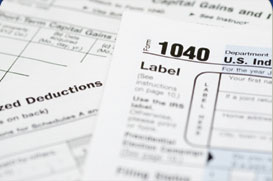
2013 year-end tax planning for individuals
Noncash charitable donations have special rules
Manage your business with a few key numbers
So how much will you owe with your 2013 federal income tax return? Not sure? You still have time to calculate your liability - and perhaps reduce it. Here are planning ideas to consider in the final months of the year.
- Check your income. Your tax rate is based on your "bracket," which is a range of income. For example, when you're single and your 2013 taxable income is between $8,926 and $36,250, you're in the 15% bracket. Additional income, up to $87,850, will be taxed at the next rate, which is 25%.
- Planning strategy 1. Consider ways to keep your income within a lower bracket as you approach the next level. One example: Increase pre-tax retirement plan contributions. For 2013, the 401(k) contribution limit is $17,500. When you're age 50 and over, you can also make an additional catch-up contribution of $5,500.
- Planning strategy 2. Consider selling real or personal property on an installment basis. Electing to receive part of the proceeds in future years allows you to defer the income and the related tax.
Estimating your taxable income before year-end opens up opportunities for effective planning. Give us a call. We'll help you choose strategies that will give you the most benefit.
In the quiet months before the conventional season of festivities and gift exchanges begins, you might not be thinking about charitable contributions. Yet if giving is part of your 2013 tax planning strategy, starting now is smart, especially if you intend to donate noncash assets. Why? Depending on the assets and their value, title transfer and appraisals can be required.
For example, say you donate appreciated stock you hold in street name with your broker. Unlike writing a check, which means the donation is delivered on the day you mail it, a gift of stock is not complete - or deductible - until ownership is transferred to the charity.
Other special rules apply to noncash donations. Here's one you may be familiar with: Clothing or household goods must be in "good used condition" or better to claim a federal income tax deduction.
And one that's probably less familiar: Guidelines for donations of cars, boats, and airplanes require you to obtain Form 1098-C from the charity when the amount you're deducting for these items is greater than $500.
Watch for an E-Blast detailing more year end strategies soon or give us a call now. Estimating your taxable income before year-end opens up opportunities for effective planning. Well help you choose strategies that will give you the most benefit.
Regardless of the type of business you're running - whether it's selling electronics, making furniture, or servicing automobiles - monitoring a few key financial indicators is often all that's needed to keep your company growing and prosperous. On the other hand, neglecting a firm's vital signs can lead to management by crisis and corrective action that's too little, too late.
A prudent business owner won't wait until the end of the year (or even the end of the quarter) to learn that revenues are declining, inventories are shrinking, or payroll expenses are spiraling out of control. Although annual financial statements provide historical perspective and a wealth of data for long-term planning, correcting current problems is a matter of timely insight and informed analysis. You want to know whether your business is losing money or growing - now, not later.
-
A company's key financial indicators often fall into one or more of the following categories:
- Orders and returns. Are you selling more units over time? To find out, look at your sales figures by units. Tracking revenues alone may present a false picture. After all, revenues may be growing because prices have increased. If unit sales are declining, you might be losing market share. Are customers returning more and more of your products? Are complaints increasing? If so, it may be time to examine your quality control process or return policy.
- Breakeven point. If you need more cash this month to cover fixed and variable costs, are you generating enough revenue to break even? If you're dipping into reserves to cover revenue shortfalls, adjustments may be required. Expenses may need to be slashed, a new advertising campaign launched, or a new and cheaper supplier procured.
- Liquidity. Knowing the availability of cash is vital to every business. That's why reconciling the firm's bank statements shouldn't be an afterthought. Every month your accountant or bookkeeper should ensure that your general ledger agrees with the bank's records of deposits and withdrawals. If a company is "bleeding cash," the bank statements should tell the story.
- Inventory. Controlling the stuff that's weighing down your retail shelves or accumulating in your warehouse is often a key to profitability. Buying too many items may lead to excessive storage costs; buying too little may lead to burgeoning backorders and lost sales.
- Payroll. Staff size should be commensurate with revenues. Medium-sized firms, especially, may find that labor expenses grow too rapidly. A decline in orders may signal a need to reduce payroll costs.
By carefully analyzing your firm's operations, you'll be able to identify the indicators that provide the clearest view of your company's ongoing profitability.
Over time your business's key numbers may change. The secret is to know your company, identify changing conditions, and adapt. A brief but timely report that presents the numbers that really matter will help to keep your firm on the right track. If you need help developing a "Financial Dashboard" for your company, let us know. We have experiencing developing, maintaining and monitoring this valuable tool for our clients.



